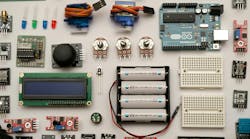The old proverb, you can’t make a silk purse out of a sow’s ear, means that you cannot create value using an inferior process or product. In industry, manufacturers are rushing to replace older equipment to achieve their Industry 4.0 goals. However, adapting their current system could be an easier way to start the journey. Here Claudia Jarett, director at obsolete industrial parts supplier EU Automation, explains how manufacturers can retrofit their way to Industry 4.0.
Industry 4.0 is moving from concept to reality and manufacturers are investing in automation to make sure they are a part of the revolution. However, aging infrastructure and outdated processes can make it difficult for plant managers to achieve this.
Interconnectivity is one of the key principles of Industry 4.0, as it gives machines and sensors the ability to connect to the Internet of Things (IoT) and communicate with each other. Manufacturers are investing in smarter equipment with increased connectivity to collect real-time data on processes and machine conditions that engineers can use to optimize the system and improve productivity.
Replace or Retrofit?
Industrial machinery is designed to be robust and long-lasting and can have a long lifespan of up to 30 years. Manufacturers should avoid rushing to replace the equipment unless absolutely necessary, for maximum return on investment. The challenge is, older industrial equipment offers limited connectivity and has less power and memory to collect data, making it less compatible with newer equipment and more challenging to connect.
However, the machine capabilities required to digitalize do not have to be built into the equipment, they can be added later on. Instead of investing in new equipment to digitalize the factory, manufacturers should first consider retrofitting their current systems with smart components. Retrofitting is a cost-efficient way of improving interoperability and productivity to bring legacy equipment into the Industry 4.0 age.
Small and medium enterprises (SMEs) can benefit from this because they are less likely to be able to afford large amounts of new equipment.
Where to Start
Manufacturers should plan and structure a retrofit, rather than randomly adding equipment to ensure they future-proof their upgraded factory. They should first focus on interoperability when planning the parts of the system to target. Implementing a monitoring and control system, such as Supervisory Control and Data Acquisition (SCADA) or Distributed Control System (DCS) can help improve this because it allows the system to operate as a whole, rather than as individual components.
Visibility is also important to help digitalize and modernize the production line. Manufacturers can integrate a new generation Human Machine Interface (HMI) to visualize and report on processes. Current machines are produced at an accelerated rate and new equipment is on the market when the previous model may still have a long lifespan, which is why an upgrade is not always necessary. Manufacturers can look to a model that is four or five years old for a cost-efficient solution that is still long-lasting.
Manufacturers can also improve interconnectivity by connecting older machines to the internet, using smart sensors. The sensor can connect to a controller, which collects data and converts it to a usable format, such as OPC-UA, so the information can be made available to the rest of the factory network.
Sourcing Equipment
Many large businesses, such as Bosch, SKF, and Festo have realized the benefits of retrofitting and offer solutions to increase the connectivity of industrial machinery. For example, Bosch Rexroth has developed its IoT Gateway software, which uses sensors and software to improve real-time monitoring and transparency. The gateway has already reduced costs by 25% at one of its own facilities—a big saving for a solution that took only four hours to fit.
Manufacturers can also purchase older equipment that is no longer produced by the original equipment manufacturer (OEM). Obsolete parts suppliers can source and deliver machines that can be retrofitted to current systems and stock the product to keep production running if the equipment ever breaks down.
To fully realize Industry 4.0, manufacturers should determine how digitalizing processes will influence product quality, downtime, and efficiency. They can then retrofit equipment to measure and communicate the information to higher-level systems, teaching old equipment new tricks. By implementing new, intelligent devices such as sensors into the production line, manufacturers can take the first step to create their factory of the future.
You may not be able to turn a sow’s ear into a silk purse, but manufacturers can use older equipment to add value to their business. By fully researching the equipment they need to improve interoperability and interconnectivity, manufacturers can find a solution that is cost-efficient and improves productivity for their business, whether that means new equipment or retrofitting the current system.











